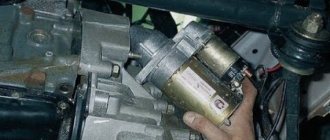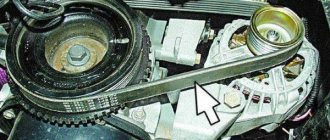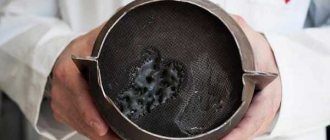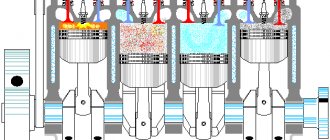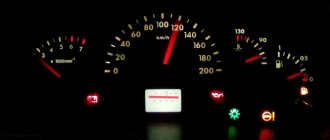Print this article Font size 16
Among experienced car owners, there are only a few who have never encountered such a phenomenon as cylinder misfires. In practice, it looks like this: the car starts to twitch, but does not move. As you understand, there is little pleasure in this.
Previously, all engines included four cylinders. When one of them failed, the engine began to fail. That is, the engine worked only on three and four cylinders.
Today there are up to 12 cylinders on passenger cars. At the same time, the phrase “troubles the engine” still remains relevant and has firmly entered into the everyday life of drivers.
Causes of misfires
If, on average, for every hundred operating cycles in the cylinder there are 3-4% cases of non-ignition of the mixture, then the VAZ 2114 engine management system begins to record misfires. There may be several reasons for this situation to occur and they do not depend on the type of engine - be it 1.5 liters or 1.6 liters.
The reasons why there are interruptions in the operation of the ignition system on the VAZ 2114 engine lie in various defects in the cylinder-piston group units, the gas distribution mechanism and the ignition system.
These problems can occur due to natural wear and tear of components or damage as a result of careless maintenance work:
- Incorrect functioning of the rough road sensor, which is installed on the VAZ 2114, meeting Euro 3 standards and higher. Because of this, when driving over uneven roads, there may be erroneous misfire signals, which disappear after driving on a good road.
- Poor mixture formation and the appearance of frost on the elements of the ignition system. Misfires may occur when starting the engine in low temperatures. On a working engine, such incidents disappear after a few seconds and are not a signal of a problem.
- Burnt out gasket between the head and block. In this case, misfires occur as the speed increases and the load on the power unit increases, i.e. during acceleration. At the same time, in idle mode the engine operates absolutely normally.
- Wear of cylinder rings and mirrors. Misfires appear on a cold engine and disappear as the unit warms up.
- Old or damaged spark plugs. Over time, the gap between the spark plug electrodes increases or becomes covered with a layer of soot. In this regard, there is not enough voltage in the ignition system for stable breakdown of the air gap and ignition.
- Faulty high-voltage wires or contacts on them. Over time, the insulation on the wires deteriorates or can become damaged during various engine maintenance tasks. With such defects, the cables are not able to provide a stable supply of high voltage to the spark plugs. The contacts on the wires themselves may become covered with corrosion products or become oily.
- Incorrect operation of the ignition module, which is installed on engines with an injector to supply a spark to the spark plugs.
- Using low-quality gasoline, which causes carbon deposits to form on the spark plugs and clog the nozzles on the injection nozzles.
- A decrease in compression pressure caused by worn rings on the pistons or loose valve seats. In turn, valve leaks can be caused by the formation of carbon deposits on the mating surfaces and incorrect adjustment of the drive mechanism.
- The engine sucks in excess air through leaks in the working mixture supply system.
Compression drop
Carbon deposits on spark plugs
Burnt gasket
The video from the KV Avtoservis channel presents the diagnosis and elimination of the cause of the misfire error.
Basic faults
Due to the extensive accumulated experience in repairing this malfunction, we can identify common factors that are inherent to any units. Common reasons that can lead to misfires in the ignition system:
- First of all, the problem may lie in the candles. Increased or decreased clearance, carbon deposits. Low quality candles. Candle with soot
- Wiring problem. Mechanical damage. Oily contact.
- Damage to the module itself or the ignition coil.
- Due to poor quality fuel, the injectors may become clogged.
- Compression in the cylinder is broken. Compression dropped
- Incorrect adjustment of the gas distribution mechanism.
- Air leakage into the fuel system due to various factors. Damage to the intake manifold, wear of the injector rings.
- For various reasons, the gap between the cylinder and the piston has decreased.
These are the main factors that are most common.
On cars without a computer, checking and identifying the cause occurs by trying different options.
Once the cause is identified, we move on to repairs. For these works you will need the help of a specialist.
Loading …
Diagnostics
The first signal of problems with the engine is the lighting of the Check Engine indicator on the instrument panel. If the car has a standard on-board computer, then you can read the ignition system errors on it. But it is not able to show the operation of the device in real time, so a more accurate way to determine the fault code is a diagnostic tool that is connected to a special connector.
Regardless of the type of equipment to check, there are several main error codes that occur when a VAZ 2114 misfires:
- P0300 - a general problem in the system, the presence of numerous misfires on all cylinders;
- P0301 - malfunction of the spark plug of the first cylinder (cylinders are counted from the unit drive pulley);
- P0302 - problems with the functioning of the second cylinder;
- P0303 - problem in the third cylinder;
- P0304 - malfunction of the fourth cylinder.
Error 0302
Error 0304
How to fix the problem?
The way to eliminate problems that arise is to replace damaged or worn parts.
It is better to correct such defects in a specialized service, where they will first clarify the cause of the problem.
Some causes of misfires in the VAZ 2114 can be found and eliminated yourself:
- If gaps and error 300 appear on the computer screen, you need to unscrew all the spark plugs, check the gap between the electrodes and see if there is a lot of carbon deposits on their surface. For errors like 0301, 0302, etc., you need to pay special attention to the condition of the spark plug in this cylinder.
- It is necessary to visually inspect the wires leading to the spark plugs; if cracks are found on the surface, they should be replaced with new ones.
- Check the condition of the camshaft drive belt and the alignment of the marks on it. If the phases are violated, it is necessary to adjust the gas distribution system.
- Check the compression, which should not be lower than 10 and not higher than 14 Bar and should not have a spread across the cylinders of more than 1 Bar. If the pressure is low, it is necessary to check the valve clearance adjustment.
- Check the clearances in the valve mechanism. Sometimes when adjusting, the clearances are set incorrectly and the exhaust valves do not close completely. Monitoring and adjustment of clearances must be carried out every 20 thousand km, and when using gas as fuel - after 10 thousand km.
- If there are misfires in different cylinders that occur under different operating conditions of the unit, the ignition module must be replaced.
Algorithm for checking elements to eliminate error P0300
Since there are many possible causes for the P0300 code, it is necessary to follow a specific troubleshooting algorithm. Here is a sequence of actions to quickly detect the cause of misfires:
- Diagnostics should begin with checking the high-voltage cables. To do this, you need to get a multimeter, set it to measure resistance (Ohms) and measure the values of the wires. If the insulation of high-voltage cables is not broken, after the test the resistance will be about 4-10 kOhm;
The above are the basic steps that most often help find the cause of the P0300 code. When checking the above elements, pay attention to their condition: the presence of soot, traces of mechanical damage, and so on.
It is necessary to determine other possible reasons for the appearance of the P0300 code, depending on what other errors the scanner indicates during diagnosis. That is, if the oxygen sensor fails, in addition to P0300, error P0134 or P0130 may occur. Try to eliminate other errors that are diagnosed along with P0300, this may resolve it immediately.
- A stuck EGR valve is also a possible cause of the P0300 code. When diagnosing your vehicle, check the long-term fuel trim value for a specific cylinder. It should differ from the ideal value (which can be found in the literature on servicing a specific car model) by no more than 1-3% in both directions. If the deviation is 7% or more, additional air intake occurs.
- Inspect the intake manifold gasket. If it is badly worn, it will need to be replaced;
What can multiple misfires lead to?
Single misfires are only a signal to the owner of a VAZ 2114 about problems with the engine.
Numerous incidents entail the following consequences:
- As a result of misfires, unburnt fuel will enter the catalytic reduction system. Because of this, the converter will overheat and fail.
- With repeated misfires, some of the gasoline will enter the lubrication system through the walls of the idle cylinder. Oil diluted with gasoline will lose its properties and will not be able to provide high-quality lubrication of loaded engine elements.
- All these factors can lead to engine failure and the need for expensive repairs.
Online consultation
Codes P0300 and P0304 are entered if:
— the engine is running; — the crankshaft speed of the N40 engine is in the range of 720...4600 rpm; — the system performs misfire recognition diagnostics (B_LUSTOP= “No”); — the uneven rotation of the crankshaft measured by the controller exceeds the threshold; — there are no fault codes P0201...P0204, P0261, P0262, P0264, P0265, P0267, P0268, P0270, P0271, P0336. If the system detects misfires that lead to an increase in exhaust gas toxicity, the malfunction indicator lamp lights up after 2 drive cycles. If the system detects a misfire leading to damage to the catalytic converter, the malfunction indicator lamp begins to flash immediately after the fault code is entered into the controller's memory. In order to protect the catalytic converter, the fuel supply may be turned off to those cylinders in which misfires have been recorded. Description of checks: 1. The presence of a permanent fault is checked. 2
It is necessary to use a spark gap (spark tester), as it is important to determine whether there is sufficient secondary voltage at the spark plug (more than 22,000 V). 3
If carbon tracks are present, replace the ignition module and check the condition of the high-voltage wires. Diagnostic information:
If misfires are intermittent, you need to check for the following faults: - unreliable grounding of the controller. Check that the injection system wires are securely connected to the cylinder block. Make sure that the contacts are not contaminated;
- air leak. Check the intake system after the mass air flow sensor for air leaks. Make sure that the vacuum hoses are connected securely and are not damaged; — malfunction of fuel supply system elements. A clogged fuel filter and a malfunction of the electric fuel pump can lead to a lean air-fuel mixture. In addition, it is necessary to check the balance of the injectors; — malfunction of ignition system elements. Check for wetness, cracks, wear, abnormal spark gap width, damage to the electrodes or large deposits on the spark plugs (if the mileage of the spark plugs on the car exceeds 30,000 km, they must be replaced). Check the high-voltage wires and the ignition module housing for damage; — weakening of the DPKV fastening; — strong (more than 0.4 mm) radial runout of the damper rim (drive disk). Misfire may occur briefly when starting a cold engine at a coolant temperature below 10°C due to dirty spark plugs. After the engine warms up, the misfires disappear.
Video “Causes of misfires”
The main causes of misfires are shown in the video from the Car-Hobby channel.
Do you have any questions? Specialists and readers of the AUTODVIG website will help you ask a question
Was this article helpful?
Thank you for your opinion!
The article was useful. Please share the information with your friends.
Yes (100.00%)
No
X
Please write what is wrong and leave recommendations on the article
Cancel reply
Rate this article: ( 4 votes, average: 5.00 out of 5)
Discuss the article:

